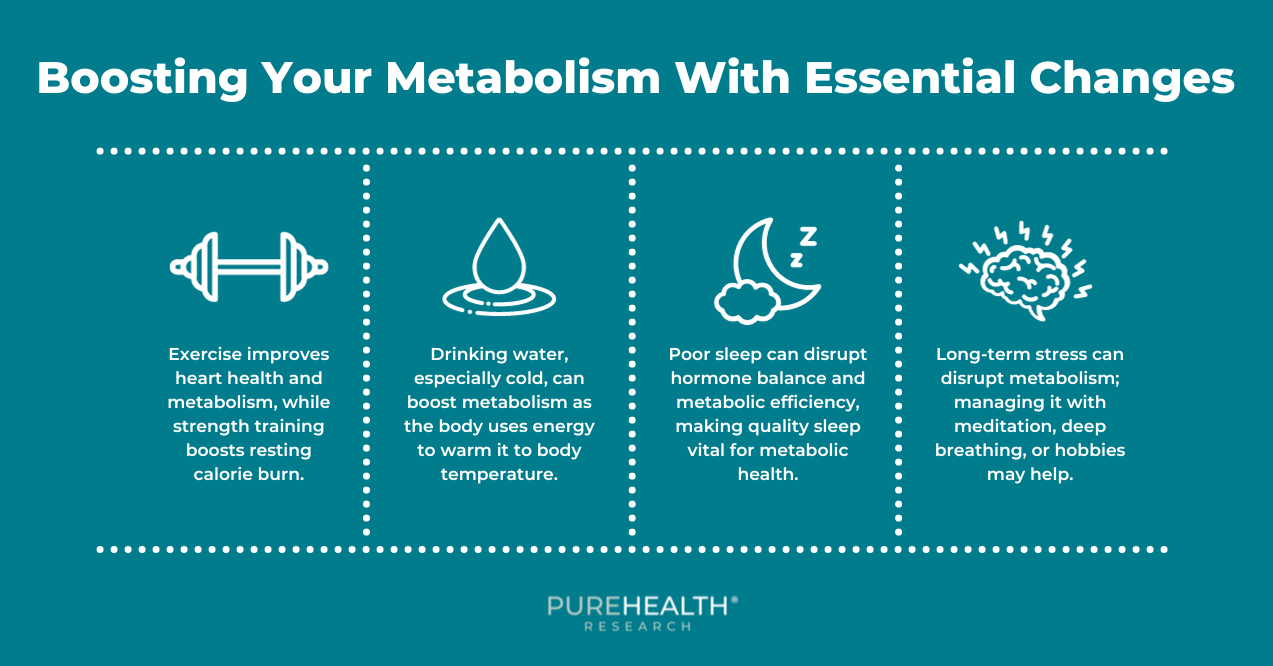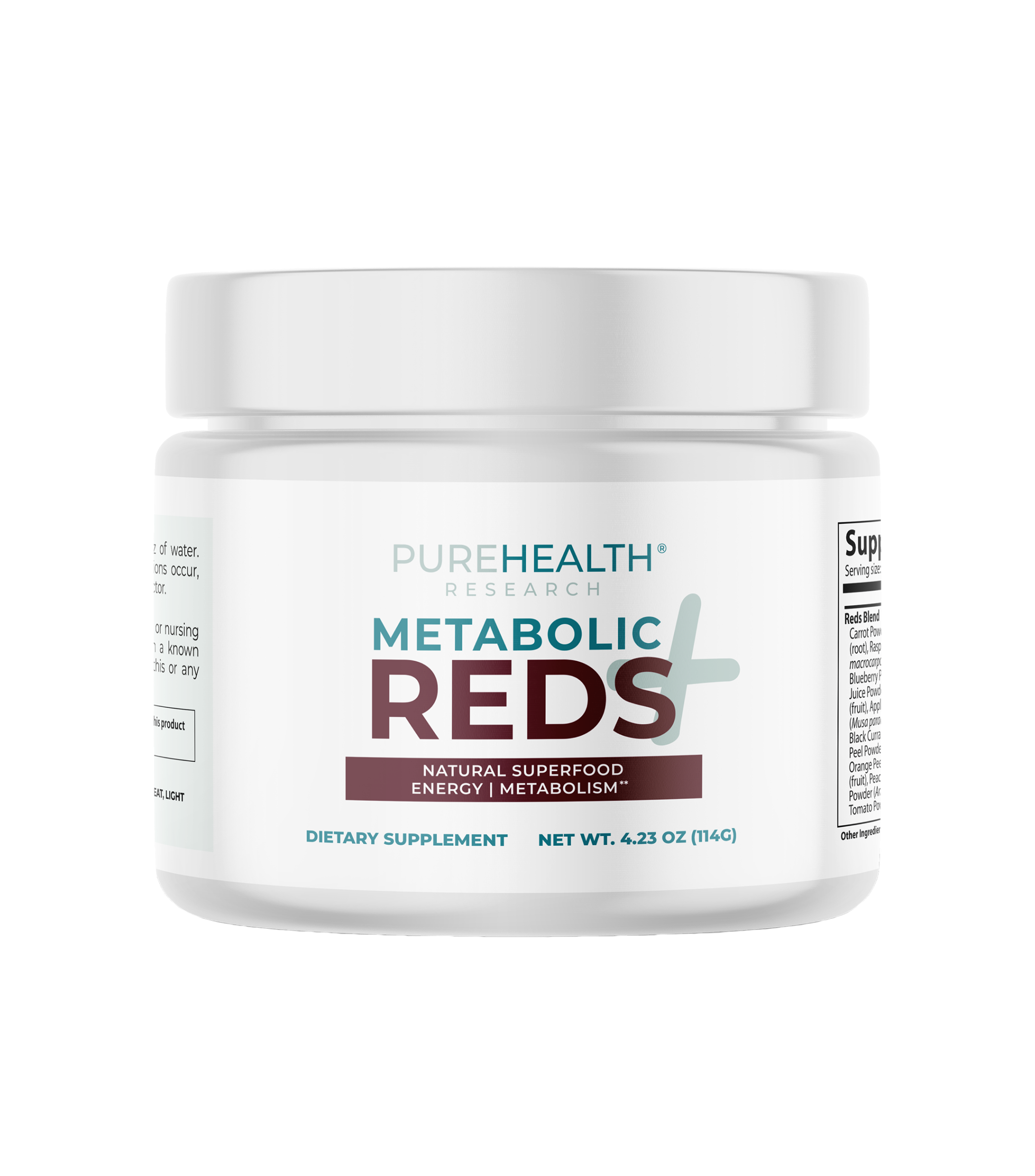What Age Does Metabolism Slow Down? Complete Guide in 2025
At what age does metabolism slow down? Learn about the age-related shifts and their effects on your body's energy dynamics. Read now to stay informed!


At its core, metabolism refers to the sum of all chemical reactions in our body that help maintain life. These reactions are responsible for breaking down nutrients to produce energy, constructing the molecules essential for growth and repair, and ensuring waste products are efficiently eliminated. With such importance in our body’s function, many people start to ask – at what age does metabolism slow down?
However, the rate at which metabolism changes isn’t uniform for everyone. Factors such as genetics, dietary habits, physical activity, and even stress may influence when and how our metabolic rate adjusts. Moreover, while certain age milestones might signify a general slowdown for many, individual variations might be vast.
Let’s dive into the fascinating world of metabolism, its significance, and the inevitable changes that time brings.
At What Age Does Metabolism Slow Down?
Throughout our lives, the rate at which our body processes food and converts it into energy undergoes several changes. These shifts in our metabolism are often linked to our age and the various phases of life we journey through. While every individual’s metabolic journey is unique, there are general patterns that most people tend to experience.
Let’s take a closer look at these life phases and how metabolism typically behaves during each:
Childhood (0-12 years):

These foundational years are marked by rapid growth and development. A child’s metabolism is naturally set to high gear, catering to their body’s demands. The energy needs during this phase are immense due to the brain’s development, bone growth, and the continuous learning and exploration kids engage in.
This speedy metabolism is also why children may often consume a significant amount of food and might remain energetic and slim. However, it’s crucial during these years to instill healthy eating habits, as these may set the tone for the future.
Teen Years (13-19 years):

Adolescence brings along a whirlwind of changes—physical, emotional, and hormonal. The body undergoes significant growth spurts, especially in the early teen years, demanding more energy.
The surge of hormones, especially testosterone in boys and estrogen in girls, may impact how their bodies store fat and use energy. While teenagers might experience hunger pangs frequently due to their quick metabolism, it’s also a time when junk food and irregular eating habits may creep in, which might affect long-term health.
Young Adults (20-30 years):

Early adulthood witnesses a gradual change in metabolism. While the early twenties may still benefit from the residual high metabolic rate of teenage years, by mid to late twenties, the metabolism starts showing signs of slowing down.
Factors contributing to this include a potential decrease in physical activity, increased responsibilities, and often a more sedentary lifestyle associated with jobs or family life. Muscle mass might also begin to decrease if not maintained through regular exercise, further impacting the metabolic rate.
Middle Age (31-60 years):

This phase might be a game-changer for many in terms of metabolism. Muscle mass, a critical factor in maintaining a healthy metabolic rate, begins to decline more significantly if not actively preserved through strength training and regular physical activity. Additionally, hormonal changes, especially in women approaching menopause, may influence how the body burns calories and stores fat.
It’s common during these years for people to notice weight gain, even if their eating habits haven’t changed significantly. It underscores the importance of staying active and making dietary adjustments to match the metabolic changes.
Senior Years (60 and older):

As one enters the senior years, the metabolism naturally slows down further. Reduced physical activity, combined with the body’s natural aging process, results in a lower basal metabolic rate. The body might not burn calories as efficiently as before, making weight management a concern for many seniors. It’s crucial during these years to focus on a nutrient-rich diet, minimize calorie-dense, nutrient-poor foods, and maintain consistent light to moderate physical activity, like walking or gentle exercises, to support overall health and well-being.
Why Does Metabolism Slow Down as You Age?
In essence, at what age does metabolism slow down is a combination of natural physiological changes and lifestyle choices. While it’s an expected part of the aging process, understanding its underpinnings may empower individuals to make informed decisions about diet and exercise, fostering a healthier and more active life even in later years.
1. Decreased Level of Being Active

The intricate relationship between physical activity levels and metabolic rate is fundamental to our understanding of energy balance and overall well-being. Simply put, metabolic rate is the pace at which our body converts the food and drink we consume into usable energy. This energy fuels everything from our heartbeats to our thoughts, to the steps we take each day. Physical activity, on the other hand, is one of the primary external factors that may support this rate of energy conversion.
Engaging in physical activities, be it brisk walking, jogging, swimming, or weight training, induces an increase in our metabolic rate. This elevation isn’t just momentary; after a workout, the body continues to burn calories at an accelerated rate, a phenomenon known as the afterburn effect or excess post-exercise oxygen consumption (EPOC).
However, as we journey through the arc of life, our inclination and ability to maintain consistent physical activity often wane. Aging brings about changes in lifestyle, priorities, and even perception of well-being. For many, the hustle and bustle of youth give way to a more sedentary lifestyle in later years. Whether it’s due to increased professional responsibilities, the comfort of routine, health-related precautions, or simply personal choices, reduced physical activity becomes a common theme.
2. Gender and Genes

When discussing the intricacies of metabolism, one cannot overlook the profound influence of genetics. Much like they shape our physical appearance and predispositions to certain health conditions, our genes also play a pivotal role in determining the speed and efficiency of our metabolic processes. Ever wondered why some individuals seem to effortlessly maintain their weight despite indulgent eating habits, while others have to be extremely cautious with their diet?
Every individual’s Basal Metabolic Rate (BMR) – the rate at which the body expends energy or burns calories while at rest – is inherently influenced by genetics. Some are naturally endowed with a higher BMR, allowing them to expend more energy even during periods of inactivity. On the other hand, some individuals, due to their genetic makeup, might have a relatively lower BMR, making them more prone to weight gain if other factors remain constant.
Furthermore, genes determine the efficiency of various metabolic pathways in our body. These pathways dictate how we process fats, carbohydrates, and proteins. Some people might genetically have a more efficient fat-burning system, while others may metabolize carbohydrates more rapidly. These genetic variations may influence how different foods affect our energy balance and weight.
Hormonal responses, another critical component of metabolism, are also under genetic control. The way our bodies respond to insulin, a hormone responsible for regulating glucose levels, or to leptin, which signals satiety, might vary based on genetic differences. Such variations may influence appetite, energy storage, and even cravings, all of which play roles in overall metabolic health.
3. Losing Muscle Mass

As we age, the natural attrition of muscle tissue, if not countered by physical activity, may contribute to a slowing metabolism. It’s one of the reasons why maintaining or even increasing muscle mass through strength training is often recommended as a strategy to counteract age-related metabolic slowdown.
Muscles play an important role in glucose metabolism. They act as primary storage sites for glucose in the form of glycogen. With regular activity, muscles become more efficient at up taking and utilizing glucose from your body, thereby aiding in the maintenance of stable glucose levels. A consistent glucose balance not only promotes energy stability throughout the day but also potentially reduces the risk of metabolic disorders.
Simply put, having more muscle means the body uses more energy, even at rest, translating to a heightened basal metabolic rate.
Can Lifestyle Changes Help?
Experiencing slow metabolism symptoms may be a concern for many individuals. A sluggish metabolism might result in fatigue, weight gain, and a decreased ability to burn calories efficiently. However, by making certain lifestyle adjustments, one might combat these symptoms and reinvigorate their metabolic rate. Here are some essential changes to consider:

Regular Exercise: Beyond just burning immediate calories, exercising serves a dual purpose. Aerobic activities, such as jogging, cycling, or swimming, enhance cardiovascular health and support the metabolic rate in the short term. Strength training, on the other hand, is a long-term investment. By building muscle mass, which is more metabolically active than fat, you’re essentially increasing the number of calories your body burns at rest. This constant metabolic uptick may counteract some of the typical symptoms of a slowing metabolism.
Stay Hydrated: Water is fundamental for metabolic processes. Drinking water might enhance your metabolic rate, and consuming cold water means the body expends a bit more energy to bring it up to body temperature, adding to the metabolic support.
Get Enough Sleep: Sleep is more than just a period of rest; it’s when the body carries out numerous essential functions, from repair to hormone production. Insufficient sleep may throw off the balance of these processes. Hormones that regulate appetite and stress might be particularly affected, influencing your metabolic efficiency. Ensuring consistent and restful sleep is crucial for metabolic health.
Manage Stress: Long-term stress may have a multitude of effects on the body, one of which is the potential to disrupt metabolic processes. Elevated stress levels might impact how our body processes and stores energy. Techniques like meditation, deep breathing exercises, or even engaging in relaxing hobbies might be beneficial in managing and reducing stress. But, there’s another aspect worth considering here: can obesity cause shortness of breath? It’s a valid concern, as excess weight often exacerbates respiratory issues, potentially leading to difficulty in breathing, especially during exertion. Thus, tackling stress not only improves metabolic health but may also alleviate the respiratory challenges associated with obesity.
Tackling these areas proactively may help individuals navigate the challenges of a slowing metabolism, ensuring a healthier and more energetic life.
Eating the Right Foods for Your Metabolism
Supporting metabolism with the right foods might be a natural way to help your body’s energy processes work more efficiently. When you opt for protein-rich options like chicken, turkey, fish, eggs, tofu, beans, and lentils, your body spends more energy digesting them. This may lead to a potential uptick in metabolic rate.
Green tea is another beneficial addition to your diet. Beyond its calming effects, it contains compounds that may increase your metabolism.
Whole grains, including oats, brown rice, and quinoa, are also worth mentioning. These grains take more energy for your body to process compared to their refined counterparts, which may be good news for your metabolism. By making such mindful choices in your diet, over time, you might support your body’s energy processes and potentially enjoy the benefits of a more efficient metabolic system.
Additionally, it is important to consider other lifestyle factors that may impact metabolism. For instance, you might wonder, does alcohol slow metabolism? The answer is yes; alcohol can indeed slow down your metabolic rate, which is why it’s advisable to moderate its consumption if you’re looking to optimize your metabolic health.
But beyond these foods, certain innovative products are designed to complement these natural metabolic supporters. One such product is Metabolic Reds+, crafted meticulously by PureHealth Research.

This supplement, endorsed by Dr. Holly Lucille, a renowned naturopathic doctor, is infused with a blend of ingredients that support your metabolic health.
The beauty of this product lies in its ability to offer a holistic approach, not just addressing metabolism but also promoting overall vitality. So, if you’re looking into how to reset your metabolism, think of it as a mix. The right foods, daily habits, and support from supplements may all help.
Conclusion
At what age does metabolism slow down is a common question, as metabolism refers to the collective chemical processes that sustain life within our bodies. Naturally, these processes begin to slow down as we age, influenced by factors such as genetics, dietary habits, physical activity, and stress.
During childhood (0-12 years), the metabolic rate is high due to rapid growth and development. In the teen years (13-19 years), growth spurts and hormonal changes affect energy needs. As young adults (20-30 years), metabolism gradually slows down, especially in the late twenties. Middle age (31-60 years) brings a decrease in muscle mass and hormonal changes that may impact metabolic rate. In the senior years (60+), metabolism slows further due to natural aging and reduced activity.
Fortunately, even if one experiences symptoms of slow metabolism, there are lifestyle changes that may help. Wondering how to reset your metabolism? Regular exercise, staying hydrated, adequate sleep, stress management, and consuming metabolism-supporting foods like protein-rich sources, green tea, and whole grains might aid in maintaining or even enhancing metabolic efficiency.
A man’s metabolism generally starts to decline between the late twenties and early thirties, influenced by factors like reduced muscle mass, lifestyle changes, and genetic predispositions. Regular exercise and a balanced diet can help counteract some of this natural slowdown.
A woman usually faces a metabolic slowdown in her late twenties to early thirties. This change results from natural aging and hormonal shifts, which influence the rate at which her body burns calories and processes nutrients.
Lifestyle factors, such as physical activity, dietary choices, stress levels, and sleep patterns, play pivotal roles in shaping metabolism for both genders. As men and women age, decreased activity can lead to muscle loss, impacting metabolic rate. Meanwhile, diet quality, sleep consistency, and stress management directly affect hormonal balance and energy processing.
Sign up for our Healthy Living newsletter!
Advertisement. This site offers health, wellness, fitness and nutritional information and is designed for educational purposes only. You should not rely on this information as a substitute for, nor does it replace, professional medical advice, diagnosis, or treatment. If you have any concerns or questions about your health, you should always consult with a physician or other health-care professional. Do not disregard, avoid or delay obtaining medical or health related advice from your health-care professional because of something you may have read on this site. The use of any information provided on this site is solely at your own risk.











